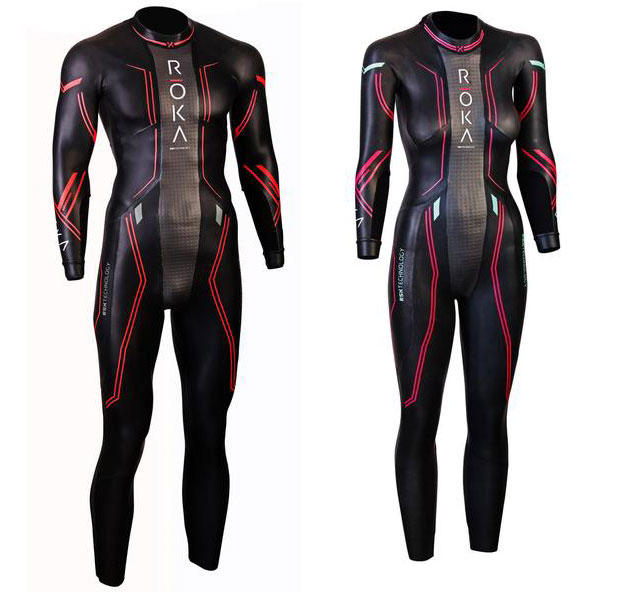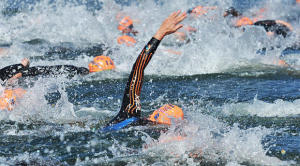You’ve got a problem when you make a really good wetsuit, which is, what you do when you need to make the next model? I’ve got some experience at that. I staked the house on a new wetsuit only to find out when finished that it was slower than my prior best effort. Humbling.
The last time a wetsuit company threw down hard on something interstellar was TYR, with the Freak of Nature. Yes, it was an exceptional wetsuit, which it ought to have been with a price tag of $1,200. I tested it. It tested very well. The only problem was, it didn’t test appreciably better than the Hurrican CAT 5, TYR’s top of the line wetsuit prior to that. That was painful to write, because TYR and Slowtwitch had a close relationship back then. Dear is Plato; dearer still the truth.
Just as TYR made some of my favorite suits 4 years ago (when I wrote about the Freak), Roka’s are some of my favorite wetsuits today. It, also, has come out with a marquis wetsuit. The question is today as it was back then: Is the Maverick X better than the Maverick Pro? What are the differences and is the upcharge justified?

First, let’s talk about how certain wetsuits are similar. Roka is, in truth, a lot like TYR. I’d say that TYR, Roka and blueseventy, and some models of Orca all have a similar feel to them. Aquaman and 2XU I also like, but are in a different “feel class." I’ll write about these other suits. (De Soto is its own cult suit and that deserves its own article, which it will get.)
What Roka, blueseventy, TYR (and some Orca) share is an elfin feel to them. Pardon, it’s just what comes to mind. Imagine the wetsuit you’d wear if you were an ogre, or a troll, a dwarf or an orc. Elves wear Rokas, or a suit by one of these other companies. These suits feel light, unobtrusive, unrestrictive. All these suits have 5mm rubber in them, but none of them feel like it and that’s the mark of a good suit: Make a 5mm suit feel like a 3mm suit.
Part of this light feel is the placement of 5mm rubber in places where it’s needed, not where it’s not. Part is placing very stretchy rubber (and stretchy jersey, the fabric on the back side of the rubber) where you can and should. Partly it’s the use of 1.5mm-thick rubber in the arms. Once I had a factory manager from the Orient visit my factory in San Marcos, CA. “You can’t glue and blindstitch 1.5mm rubber,” he said. “Yes, but you are here, in my factory, watching it happen.” “Yes,” he answered. “I’m watching it. Still, it can’t be done.”
I understood his point. We were the first to do it. Today the best factories can do this, as in Roka’s case. In truth, I don’t know that it’s necessary. Making the arms of 2.0mm rubber is probably fine, but then you don’t quite get that elfin feel.
Finally, there is a way to create patterns using a glue & blindstitch method that you can’t get out of any other kind of fabric. A master pattern maker can create contours by glueing pattern pieces that have curved edges. This takes a kind of genius I don’t understand, but my pattern makers could do it. A fullsuit can feel like a form-fitting Spiderman suit while another, made of exactly the same materials and processes, can feel like a potato sack. How does Roka do at this?

Roka is better than we were at patterns from the waist up. I think we were better than Roka from the waist down. But then we were better than anybody from the waist down. Nobody had a better set of waist-down patterns than Quintana Roo’s suits from the mid-to-late 1990s and in my opinion this continues through today. Like Italian factories that turned out silk tubular tires in 1980, only a top caliber tire manufacturer makes their equal today.
Where most wetsuit makers have moved well past us is in the neck, neck closure, zipper base, and in the arms. Our suits were very good, but they don’t compare to the Roka suits made today.
A lot of people familiar with surface swimming wetsuits fault pool tests. They think pool testing doesn’t reward a suit that holds its form during the second half of an open-water swim. Fine. But then wind tunnel testing also doesn’t reward a bike that exhibits qualities on the open road. I wouldn’t make a wetsuit decision until I’d swam it down against those in its competitive set in a pool, as well as trying it for a kilometer in the open water. I’ll know a really good suit when I feel the sting of “new” cold water entering two-thirds of the way into the swim. That means I’ve been in a dry suit until that point (at least in that part of my body). I know a bad suit when I feel like I’m swimming in galoshes during the second half of an open water swim.
The Maverick X has a special feature that the Maverick Pro does not have. Here it is in Roka’s own words: "We inverted the existing paradigm and started with the arms up, the most crucial phase of the freestyle stroke. Early prototypes and testing revealed that there was a golden ratio, a sweet spot for the arm position and patterning, that allowed for zero restriction and total mobility throughout the stroke. Revolution X is a result of that unique patent pending process.”
This makes perfect sense. Make the default position the superman position, and create a suit with arms that snap back to that position. Instead of fighting the suit during the recovery and extend phase, the suit should aid you in getting back to the extend phase. Is this new?

De Soto had a similar narrative more than a decade ago. Here are my own words, from 2005: "There is one additional change De Soto made between last year and this... The arm contour was rotated, such that the natural state of a T1 wetsuit is with your arms atop your head, such as during the catch phase of the stroke. The suit fits better that way. The idea is to have the suit's pattern trend toward that state, so the rubber wants to go where you're taking it, instead of fighting against the user's intentions.”
Is this what Roka is doing? Not quite. De Soto, as well as I can tell, literally rotated the pattern around the shoulder, as around the face of a clock. The Maverick X doesn’t feel like that; doesn’t look like the De Soto did; doesn’t fit or function like the De Soto. Roka simply changed its pattern. That might seem like a distinction without a difference, but that’s the best I can tell you.
The Maverick X, like all Roka wetsuits, has a very solid zipper base, calf area and ankle. This is important, because this is where suits fail. The suit needs to come off quickly, but without your heel punching a hole through the calf when you’re putting the darned thing on.
The Maverick X comes with a center run of Yamamoto Aerodome for extra buoyancy, and like the blueseventy Helix and the TYR suits I feel good core stability without feeling like I’m in a girdle or straightjacket. That’s one way good wetsuits aid in body position. The second is in flotation, front-to-back. This is tough, because it’s swimmer-dependent. When we took our wetsuits to the flume, we actually found national class pool swimmers who were best off with long arms and no legs (that is, the wetsuit had no legs). But the typical triathlete wants good but not massive low body flotation. I’m happy with how the Maverick X delivers this, but then I was happy with the Maverick Pro.
The Maverick X has a textile forearm. Thankfully they don’t call it a pulling panel. I haven’t yet seen a pulling panel that actually works. I have seen pulling panels that were slower than a rubber-throughout forearm (one of which was my own, mentioned in the first paragraph). I keep waiting for the fabric panels on my Helix and Maverick to tear, but they don’t. They are much more robust than they feel and look.

Is the Maverick X a better suit than the Maverick Pro? The only pattern change I can really feel is in the arm. It’s easier for me to say yes, upgrade to the Maverick X than it was when I reviewed the Freak, because the difference here is $700 to $900 rather than from $600 to $1,200. Still, I feel like we’re talking two fancy new cars here, one has a back-up camera and a navigation system the other doesn’t. They’re very close. I suppose that’s the idea: Price them so that it’s not easy justifying one over the other.
One final note on these wetsuits. When I was done at QR we had 17 sizes: 13 men’s and 4 women’s. We started with a standard size run of 6 or 7 suits in 1987, and then we kept adding morphological offshoots, that is, we had a size-M and then we’d need a suit that fit a size-M guy perfectly from crotch to notch but the arms and legs were way too long. So we made what we called a Medium-Short. We eventually had 5 morphological digressions.
Roka has that. They make 9 men’s sizes, and 3 are morphological digressions. That’s probably all they need. What Roka does that we did not do was replicate this effort with great specificity for women. In fact, Roka has more sizes for women (11) than for men (9), and 4 of those are morpho sizes. Bravo.
Roka has a style about it. The company I’m talking about. It feels like Apple or Under Armour. The company is largely consumer direct at this point and we’ll see how that goes. When I started making wetsuits, coming up on my 30 year anniversary of backing into this industry by accident, mail order was the way most of our wetsuit were sold because we had no business, no dealers, and it was a brand new category (imagine convincing a bike shop it should carry a wetsuit when the shop had never heard of a triathlon wetsuit). I grew my business that way, and while it’s a luxury to try a wetsuit on before choosing, it’s not mandatory.
You’ll read more about Roka’s Maverick X here.


